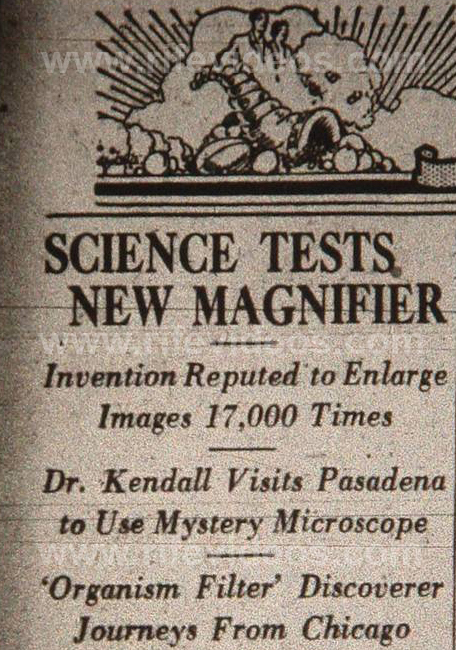Science Tests New Magnifier |
Science Test New Magnifier
Los Angeles Times, November 20, 1931
Invention Reputed to Enlarge Images 17,000 Times
Dr. Kendall Visits Pasadena to Use Mystery Microscope
'Organisms Filter' Discoverer Journey From Chicago
Surrounded by the utmost secrecy during the fourteen years required to perfect it, what is described as the world’s most powerful microscope, believed to be nine times as powerful as any other in existence, came to light this afternoon.
The microscope, which medical men think will vastly widen the bacteriological field, was viewed for the first time by a layman in the small laboratory compartment at the Pasadena Hospital.
At present it is being used by Dr. Arthur Isaac Kendall of Northwestern University, who recently was reported to have completed research which may explain the spreading of contagious diseases.
Meeting Arranged
The instrument is said to have been perfected after fourteen years of effort by Dr. Royal Raymond Rife of San Diego. Upon learning that a microscope of exceptional power had been invented, Dr. Kendall arranged to meet Dr. Rife in this city, where they have been working quietly for several days in a joint effort to shed additional light on one of humanity's greatest scourges.
As a Times reporter blundered into the small compartment he was hustled outside so rapidly that he caught only a fleeting mental image of an unfamiliar instrument equipped with shining crystals.
The inventor Dr. Rife, it was learned, became interested in optics as a young man and was aided by a wealthy San Diego family.
In its present state of development the new microscope is reliably reported to have a visual magnifying power of 17,000 diameters, compared with the 2000 diameters, said to be the limit of commercial instruments.
Due to the fact that images are born to the eye by light waves measuring about 50-1000ths of an inch in length, it has been supposed that no object considerably less than that in length would be seen by the human eye.
By the use of quartz prisms, it is understood that Dr. Rife has broken up the light waves, making it possible to bring "impossibly" small objects to view. Through the new microscope, according to estimates, and object measuring 1 100 – 1000ths of an inch in diameter would be magnified to appear one sixth of an inch in diameter.
Recent Discovery
Dr. Kendall, professor of research bacteriology at Northwestern, recently showed that certain organisms, when propagated in a special environment, developed into a peculiar form possessed of this strange power to worm their way through porcelain filters. When changed back to their previous environment, he found they resume their previous form.
This sudden change in the organism, it is suspected, explains hitherto unknown causal factors in spreading contagious diseases.
Local scientists, who were consulted, expressed considerable doubt about the perfection of a microscope which appears to transcend the limits set by optical science.
"Seeing is believing!" Is the report of others, who declare that a man of Dr. Kendall's standing would not have journeyed 2000 miles to use of microscope unless it possessed unprecedented power.
The Northwestern University scientist’s work here virtually is completed, it is reported, and results achieved with the new instrument are scheduled to be presented at a meeting of Southern California medical men within a short time.
|

